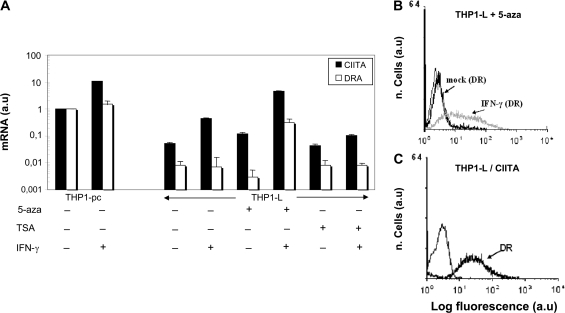Fig. 2.
Treatment with 5-aza restores CIITA and consequent HLA-DR inducibility by IFN-γ in THP1-L. (A) Quantitative analysis by real-time RT–PCR of CIITA and DRA transcript. THP1-L cells were treated with 5-aza for 5–7 days or with TSA for 2 days. Freshly prepared 5-aza was added to cultures every day. Thereafter, THP1-L and THP1-pc were treated with IFN-γ for 2 days and total RNA was extracted. The housekeeping normalized data value obtained in mock THP1-pc was defined as the arbitrary unit (value 1). All other normalized PCR data values were then expressed as fraction or multiple of the arbitrary unit (mRNA a.u.) in the ordinate in a log scale. Bars represent the standard deviation from the mean of three distinct experiments. (B) THP1-L cells treated with 5-aza for 5 days were then cultured in absence (mock) or in presence of 150 U ml−1 IFN-γ (IFN-γ) for 2 days and analysed for HLA-DR surface expression by indirect immunofluorescence and flow cytometry. The results shown are from one representative experiment of three with similar results. (C) THP1-L cells were transfected with a CIITA expression vector under the control of CMVp. Stable bulk transfection was obtained under G418 selection and further subcloned. HLA-DR surface expression (DR) was evaluated by indirect immunofluorescence and flow cytometry. Results refer to a representative clone of 10 with similar DR phenotype.

